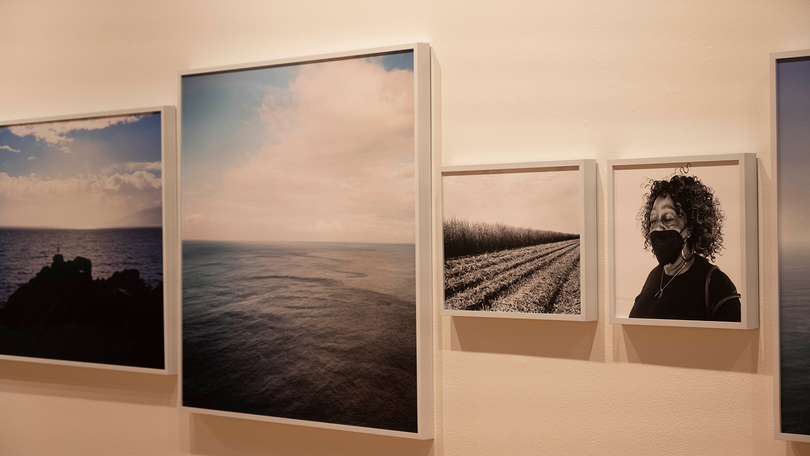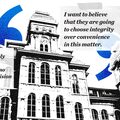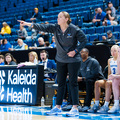‘Everything Nice’ honors African diaspora’s resilience with vivid photographs

Sasha Phyars-Burgess had been curious about her ancestor’s relation to the slave trade since childhood. She explored this question through her photography exhibit “Everything Nice,” currently on display at Light Work. Chrisitan Calabrese | Asst. Photo Editor
Get the latest Syracuse news delivered right to your inbox.
Subscribe to our newsletter here.
Vibrant earthy tones of green and blue bring a white-walled gallery room to life. Photographs of everyday people, beaches, sugarcane fields and agricultural machinery draw visitors into the rhythms of a Caribbean island.
“It’s an exhibition that asks the viewer to slow down and to read the images like you would read a text,” photographer Sasha Phyars-Burgess said. “I hope the viewers are transported, I hope that they are curious.”
“Everything Nice,” created by Trinidadian-American photographer Phyars-Burgess, is on display at Syracuse University’s Light Work through Dec. 5. The photographs explore histories of slavery, sugarcane cultivation and survival across the African diaspora.
The exhibit is named after dancehall artist Popcaan’s 2014 hit, “Everything Nice.” Phyars-Burgess said she aimed for the exhibit to mirror the song’s message. Phyars-Burgess views the song’s perspective as essential to the resilience of the African diaspora.
“(The song) really asks the viewer to both reckon with the intensity of this history and the actuality of the present day, and the idea of how people endured through this,” Phyars-Burgess said.
The project itself began with her childhood question: “What were my Trinidadian ancestors doing during the Transatlantic Slave Trade?” She began researching her family’s history. When she discovered they were harvesting sugarcane, she dove deeper into the agricultural and colonial history of the crop, researching where it had been planted.
As Phyars-Burgess continued her research, she reflected on how enslaved Africans were treated as interchangeable, valued only as commodities that could be moved and exchanged at will.
Her photographs span sites across Louisiana, Florida, the Caribbean and beyond — landscapes marked by sugar and slavery. Phyars-Burgess said she shot in multiple formats, from 35mm to large-format 4×5, to evoke shifts in time.
The exhibit’s path to Light Work began at Bard College, where Lucas Blalock, a photography professor there, first encountered Phyars-Burgess’ work during an artist talk about a year ago.
Blalock had also recently curated his own show at Light Work called “Peppy Downer.” Impressed by her work, he introduced her to Whitney Hubbs, Light Work’s associate director, as a strong fit for the program.
Hubbs collaborated with Phyars-Burgess on the exhibit, assisting with curation and installation since early 2024. Hubbs said in their first conversations, she “slowly entered into Sasha’s mind.”
Hubbs said she felt it was important to understand Phyars-Burgess’ intellect and emotional landscape and keep true to her vision. The curatorial process was collaborative, and Hubbs’ role was to guide rather than control.
“It’s a conversation,” Hubbs said. “It’s not my story to tell.”
Together, they narrowed thousands of photographs into a focused narrative. Grouping the seascapes together emphasized the theme of journeys, Hubbs said. They paired the photos with black-and-white images that gave the exhibit contrast and brought it into the present.
For Blalock, the urgency of Phyars-Burgess’ art lies in how it connects stories from the past to the present, especially when conceptions of history can be muddy, he said.
“There’s a lot of energy in our culture that wants to forget it or not take any responsibility at all for the fact that these things happened,” Blalock said. “And so I think the work she’s doing is very important.”
Phyars-Burgess said the project will eventually expand to include photographs from Brazil, South Africa, Senegal, Cabo Verde, Ghana and Trinidad and Tobago. Her vision for “Everything Nice” extends beyond Syracuse, with plans for future exhibits in public libraries and galleries across different communities. The installation at Light Work represents only the first phase of a much larger project, she said.
Students engaging with her work is important to Phyars-Burgess. She hopes the images spark curiosity and that students recognize the sense of journey in the photographs.
She hopes emerging photographers expose themselves to a wide range of work so they can see how different artists use the camera to explore ideas in their own way — a lesson that was important in her own artistic development.
“It was important for me to know that photography could actually be a way to express myself,” Phyars-Burgess said.






